Motion In A Straight Line MCQs
NEET Physics For Motion In A Straight Line Multiple Choice Questions
Question 1. Two particles move with initial speeds of 4 ms-1 and 2 ms-1 and their accelerations are 1 ms-2 and 2 ms-2 respectively. If both reach at final position at the same time, then the length of the path travelled is:
- 12 m
- 24 m
- 36 m
- 48 m
Answer: 2. 24 m
Given
Two particles move with initial speeds of 4 ms-1 and 2 ms-1 and their accelerations are 1 ms-2 and 2 ms-2 respectively. If both reach at final position at the same time,
According to the question, two particles reach at final position in the same time distance covered S and time t will remain the same.
⇒ From equation of motion,\(S=u t+\frac{1}{2} a t^2\)
For st particle S=\(4(t)+\frac{1}{2}(1) t^2 =4 t+\frac{t^2}{2}\)
⇒ For 2nd particle S=\(2(t)+\frac{1}{2}(2) t^2 =2 t+t^2\)
Equating equation .1 and equation .2 we get,\(4 t+\frac{t^2}{2}=2 t+t^2\) t=4s
∴ Putting the value of t in equation .1 we have\(S=4(4)+\frac{16}{2}=24 \mathrm{~m}\)
Question 2. A particle starting from the origin (0,0) moves in a straight line in the (x,y)plane. Its coordinates at a later time are (√3,3) The path of the particle makes with the x-axis an angle of:
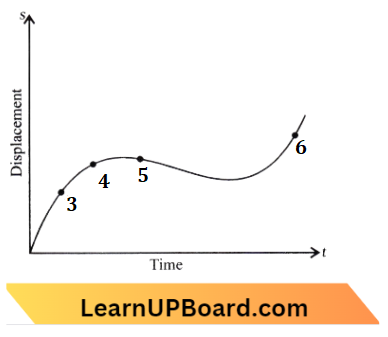
- 45°
- 60°
- 0°
- 30°
Answer: 2. 60°
Here, \(\tan \theta=\frac{3}{\sqrt{3}}=\sqrt{3}\)
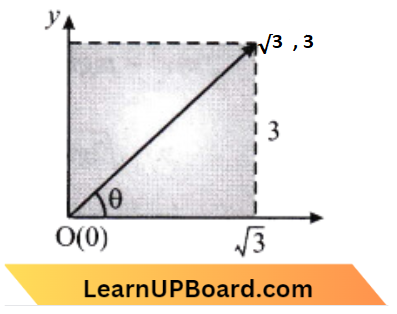
∴ θ=60
Motion In A Straight Line MCQs
Question 3. The displacement-time graph of moving particles is shown below. The instantaneous velocity of the particle is negative at the point:
- D
- F
- C
- E
Answer: 4. E
∴ Instantaneous velocity is the slope of the displacement time graph. At point E, the slope is negative so the instantaneous velocity of the particle is negative. At points C and 4 the slope is positive and at D, the slope is zero.
Read and Learn More NEET Physics MCQs
Question 4. A body starts from rest, what is the ratio of the distance travelled by the body during the 4th and 3rd s?
- \(\frac{7}{5}\)
- \(\frac{5}{7}\)
- \(\frac{7}{3}\)
- \(\frac{3}{7}\)
Answer: 1. \(\frac{7}{5}\)
Distance travelled by the body in the second is given by \(s_n=u+\frac{a}{2}(2 n-1)\)
Here, u=0
⇒ For 4th second,\(s_4=\frac{a}{2}(2 \times 4-1)\)
For3’d second,\(\frac{a}{2}(2 \times 3-1)\)
∴ Hence,\(\frac{s_4}{s_3}=\frac{(2 \times 41)}{(2 \times 3 \quad 1)}=\frac{7}{5}\)
Motion In A Straight Line MCQs
Question 5. What will be the ratio of the distance moved by a freely falling body from rest in the 4th and 5th second of the journey?
- 4: 5
- 7: 9
- 16: 25
- 1: 1
Answer: 2. 7: 9
As distance travelled in nth sec is given by, \(s_n=u+\frac{1}{2} a(2 n-1)\)
Here, w= 0, acceleration due to gravity a = 9.8 m/s2
⇒ For 4th second,\(s_4=\frac{1}{2} \times 9.8(2 \times 4-1)\)
And for 5th second,\(s_5=\frac{1}{2} \times 9.8(2 \times 5-1)\)
∴ \(\frac{s_4}{s_5}=\frac{7}{9}\)
Question 6. A person travelling in a straight line moves with a constant velocity of v1 for a certain distance V and with a constant velocity of v2 for the next equal distance. The average velocity v is given by the relation :
- \(\frac{1}{v}=\frac{1}{v_1}+\frac{1}{v_2}\)
- \(\frac{2}{v}=\frac{1}{v_1}+\frac{1}{v_2}\)
- \(\frac{v}{2}=\frac{v_1+v_2}{2}\)
- \(v=\sqrt{v_1 v_2}\)
Answer: 2. \(\frac{2}{v}=\frac{1}{v_1}+\frac{1}{v_2}\)
⇒ \(t_1 =\frac{x}{v_1} \text { and } t_2=\frac{x}{v_2}\)
v =\(\frac{x+x}{t_1+t_2}=\frac{2 x}{\frac{x}{v_1}+\frac{x}{v_2}}=\frac{2 v_1 v_2}{v_1+v_2}\)
∴ \(\frac{2}{v}=\frac{1}{v_1}+\frac{1}{v_2}\)
Question 7. A toy car with charge q moves on a frictionless horizontal plane surface under the influence of a uniform electric field E. Due to the force qE, its velocity increases from 0 to 6 m/s in one second. At that instant, the direction of the field is reversed. The car continues to move for two more seconds under the influence of this field. The average velocity and the average speed of the toy car between 0 to 3 seconds respectively will be:
- 1 m/s, 3.5 m/s
- 1 m/s, 3 m/s
- 2 m/s, 4 m/s
- 1.5 m/s, 3 m/s
Answer: 2. 1 m/s, 3 m/s
Given
A toy car with charge q moves on a frictionless horizontal plane surface under the influence of a uniform electric field E. Due to the force qE, its velocity increases from 0 to 6 m/s in one second. At that instant, the direction of the field is reversed. The car continues to move for two more seconds under the influence of this field.
0s < t < Is: velocity increases from 0 m/s to 6 m/s
⇒ ls<t<2s: velocity decreases from 6 m/s to 0 m/s but car continues to move forward
⇒ 2s < t < 3s: Since field strength is the same.
That is the same acceleration.
Therefore, the car’s velocity increases from 0 m/s to -6m/s
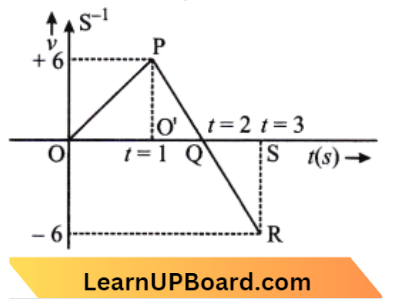
Displacement in three seconds = Area under graph = Area of AOPO’ + Area of APO’Q – Area of QRS
⇒ \(\frac{1}{2} \times 1 \times 6+\frac{1}{2} \times 1 \times 6-\frac{1}{2} \times 6 \times 1=3 \mathrm{~m}\)
Average velocity =\(\frac{3}{3}\)= 1 ms-1
Total travelled distance = 9 m
∴Average speed = \(\frac{9}{3}\) = 3 ms-1
MCQs on Motion in a Straight Line for NEET
Question 8. Preeti reached the metro station and found that the escalator was not working. She walked up the stationary escalator in time ty. On other days, if she remains stationary on the moving escalator, then the escalator takes up time f2. The time taken by her to walk up on the moving escalator will be:
- \(\frac{t_1+t_2}{2}\)
- \(\frac{t_1+t_2}{t_2-t_1}\)
- \(\frac{t_1 t_2}{t_1+t_2}\)
- \(t_1-t_2\)
Answer: 3. \(\frac{t_1 t_2}{t_1+t_2}\)
Given
Preeti reached the metro station and found that the escalator was not working. She walked up the stationary escalator in time ty. On other days, if she remains stationary on the moving escalator, then the escalator takes up time f2.
Velocity of girl with respect to elevator= \(\frac{d}{t_1}=\mathrm{v}_1\)
Velocity of elevator with respect to ground =\(\frac{d}{t_2}=\mathrm{v}_2\)
The velocity of the girl concerning ground = vg=v1+v2
⇒ \(\frac{d}{t}=\frac{d}{t_1}+\frac{d}{t_2}\)
⇒ \(\frac{1}{t}=\frac{1}{t_1}+\frac{1}{t_2}\)
∴ \(\mathrm{t}=\frac{t_1 t_2}{t_1+t_2}\)
Question 9. A particle covers half of its total distance with speed v1 and the rest half the distance with speed v2. Its average speed during the complete journey is:
- \(\frac{v_1 v_2}{v_1+v_2}\)
- \(\frac{2 v_1 v_2}{v_1+v_2}\)
- \(\frac{2 v_1 v_2}{v_1+v_2}\)
- \(\frac{v_1+v_2}{2}\)
Answer: 2. \(\frac{2 v_1 v_2}{v_1+v_2}\)
We know the formula, s=vt from v=\(\frac{s}{t}\)
∴The Average speed of particle is,\(v_{a v}=\frac{s+s}{\frac{s}{v_2}+\frac{s}{v_2}}=\frac{2 v_1 v_2}{v_1+v_2}\)
Question 10. A ball is dropped from a high-rise platform at t = 0 starting from rest. After 6 s another ball is thrown downwards from the same platform with a speed v. The two balls meet at t = 18 s. What is the value of v? (take g = 10 ms-2)
- 74 ms-1
- 55 ms-1
- 40 ms-1
- 60 ms-1
Answer: 1. 74 ms”
Given
A ball is dropped from a high-rise platform at t = 0 starting from rest. After 6 s another ball is thrown downwards from the same platform with a speed v. The two balls meet at t = 18 s.
According to the question, For the first ball, u = 0
⇒ \(s_1=\frac{1}{2} g t_1^2=\frac{1}{2} \times g(18)^2\)
For second ball, \(s_2=v t_2+\frac{1}{2} g t^2\)
⇒ \(t_2=18-6=125\)
⇒ \(s_2=v \times 12+\frac{1}{2} g(12)^2\)
Here, s1-s2 \(\frac{1}{2} g(18)^2=12 v+\frac{1}{2} g(12)^2\)
∴On Solving We get, V= 74ms-1
MCQs on Motion in a Straight Line for NEET
Question 11. Two particles which are initially at rest, move towards each other under the action of their internal attraction. If their speed is v and 2v at any instant then the speed of the centre of mass of the system will be:
- 2v
- 0
- 1.5v
- v
Answer: 2. 0
The conditional main acceleration of parts is zero means COM=0
This shows that the speed of the centre of mass of the system is always zero.
Question 12. A particle moving along the x-axis has acceleration f at time t, given by \(f=f_0\left(1-\frac{t}{T}\right)\), where f0 and T are constants. The particle at t = 0 has zero velocity. In the time interval between t = 0 and the instant when f = 0, the particle’s velocity (VR) is:
- \(\frac{1}{2} f_0 T^2\)
- f0t2
- \(\frac{1}{2} f_0 T\)
- f0T
Answer: 2. f0t2
Given
A particle moving along the x-axis has acceleration f at time t, given by \(f=f_0\left(1-\frac{t}{T}\right)\), where f0 and T are constants. The particle at t = 0 has zero velocity. In the time interval between t = 0 and the instant when f = 0
⇒ \(\frac{d v}{d t}=f =f_0\left(1-\frac{t}{T}\right)\)
⇒ \(\int_0^v d v =f_0 \int_0^T\left(1-\frac{t}{T}\right) d t\)
v =\(f_0\left(t-\frac{t^2}{2 T}\right)_0^T\)
= \(f_0\left(T-\frac{T^2}{2 T}\right)=\frac{1}{2} f_0 T\)
Question 13. Three different objects of masses mls m2 and m3 are allowed to fall from rest and the same point 0 along three different frictionless paths. The speeds of the three objects on reaching the ground will be in the ratio of:
- m1 : m3 : m3
- m1 : 2m2 : 3m3
- 1: 1: 1
- \(\frac{1}{m_1}: \frac{1}{m_2}: \frac{1}{m_3}\)
Answer: 3. 1 : 1 : 1
When an object falls freely under gravity, then its speed “depends only on its height of fall and is. independent of the mass of the object. As all objects are falling through the same height, therefore their speeds on reaching the ground will be in the ratio of 1:1:1.
Question 14. A car accelerates from rest at a constant rate for some time, after which it decelerates at a constant rate of P and comes to rest. If the total time elapsed is t, then the maximum velocity acquired by the car is:
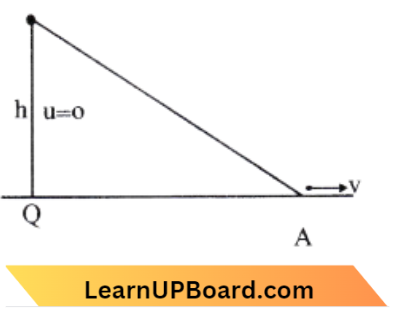
- \(\left(\frac{\alpha^2+\beta^2}{\alpha \beta}\right)t\)
- \(\left(\frac{\alpha^2-\beta^2}{\alpha \beta}\right)t\)
- \(\left(\frac{\alpha-\beta}{\alpha \beta}\right)t\)
- (\(\left(\frac{\alpha \beta t}{\alpha+\beta}\right)\)
Answer: 4. (\(\left(\frac{\alpha \beta t}{\alpha+\beta}\right)\)
This situation is plotted on a (v-t) graph. In the (v-t) graph, OA represents the accelerated part and AB represents the decelerated part.

⇒Let t1 and t2 be the times for parts OA and AB respectively. At point A velocity is maximum and let it be v max. But,t = t1 +t2
=\(v_{\max }\left(\frac{1}{\alpha}+\frac{1}{\beta}\right)=v_{\max }\left(\frac{\alpha+\beta}{\alpha \beta}\right)\)
MCQs on Motion in a Straight Line for NEET
Question 15. A car covers the first half of the distance between two places at 40 km/h and the other half at 60 km/h. The average speed of the car is:
- 40 km/hr
- 48 km/hr
- 50 km/hr
- 60 km/hr
Answer: 2. 48 km/hr
Let the distance between two places be d and t1 is the time taken by the car to travel the first-half length, and t2 is the time taken by the car to travel the second-half length. Time taken by car to travel first half
length,\(t_1=\frac{\left(\frac{d}{2}\right)}{40}=\frac{d}{80}\)
⇒ Time taken by car to travel second-half length,\(t_2=\frac{\left(\frac{d}{2}\right)}{60}=\frac{d}{120}\)
Total Time ,t=t1+t2 = \(\frac{d}{80}+\frac{d}{120}\)
⇒ \(d\left(\frac{1}{80}+\frac{1}{120}\right)=\frac{d}{48}\)
∴Average speed, =\(\frac{d}{t_1+t_2}=\frac{d}{\left(\frac{d}{48}\right)}\) = 48 km/h
Question 16. A car is moving along a straight road with a uniform acceleration. It passes through two points P and Q separated by a distance with a velocity of 30 km/h and 40 km/h respectively. The velocity of the car midway between P and Q is:
- 33.3 km/h
- 20 V2 km/h
- 35 V2 km/h
- 0.35 km/h
Answer: 3. 35 V2 km/h
Given
A car is moving along a straight road with a uniform acceleration. It passes through two points P and Q separated by a distance with a velocity of 30 km/h and 40 km/h respectively.
Let x be the total distance between points P and Q and v be the velocity of the car while passing a certain middle point of PQ.
If a is the acceleration of the car then,

For part PQ, 402 – 302 = 2ax
⇒For part RQ, \(40^2-v^2=\frac{2 a x}{2}\)
We have,\(40^2-v^2=2\left(\frac{350}{\mathrm{x}}\right) \frac{x}{2}\)
∴v2= 1250 \(v=35 \sqrt{2} \mathrm{~km} / \mathrm{h}\)
MCQs on Motion in a Straight Line for NEET
Question 17. A car of mass m starts from rest and accelerates so that the instantaneous power delivered to the car has a constant magnitude of P0. The instantaneous velocity of the car is proportional to:
- \(t^2 P_0\)
- \(t^{\frac{1}{2}}\)
- \(t^{-\frac{1}{2}}\)
- \(\frac{t}{\sqrt{m}}\)
Answer: 2. \(t^{\frac{1}{2}}\)
We know that power, P0= F. v.
⇒ \(P_0=m v \cdot \frac{d v}{d t}\)
Interesting we get; \(\int m v d v=\int \mathrm{P}_0 d t\)
⇒\(\frac{m v^2}{2}=P_0 t\)
∴\(v \propto \sqrt{t}\)
Question 18. A bus is moving at a speed of 10 ms-1 on a straight road, Ascooterist wants to overtake the bus in 100 s. If the bus is at a distance of 1 km from the scooterist, with what speed should be sooterist chase the bus?
- 20 ms-1
- 40 ms-1
- 25 ms-1
- 10ms-1
Answer: 1. 20 ms-1
S=Scooter
B=bus
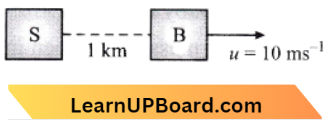
Let v = relative velocity of S w.r.t. B
v = vs – vb
⇒ vb = V + Vg → 1
Relative Velocity = \(\frac{\text { Displacement }}{\text { time }}\)
⇒\(\frac{1000}{100}=10 \mathrm{~ms}^{-1}\)
∴ Putting this value in the equation. 1, Vs= 10 + 10 = 20 ms
Motion in a Straight Line NEET Questions
Question 19. A particle shows the distance-time curve given in the figure. The maximum instantaneous velocity of the particle is around the point:
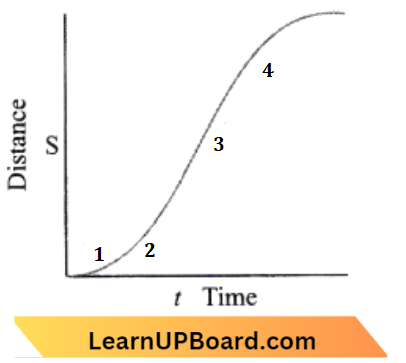
- 2
- 3
- 4
- 1
Answer: 3. 4
In the distance-time graph, the speed at the instant is expressed by the slope at that instant. The slope is maximum at C.
Question 20. A car moves from X to Y with a uniform speed vu and returns to Y with a uniform speed v. The average speed for this round trip is:
- \(\sqrt{v_u v_d}\)
- \(\frac{v_d v_u}{v_d+v_v}\)
- \(\frac{v_u+v_d}{2}\)
- \(\frac{2 v_d v_u}{v_d+v_u}\)
Answer: 4. \(\frac{2 v_d v_u}{v_d+v_u}\)
Average speed=\(\frac{\text { Total distance }}{\text { Total time }}\)
=\(\frac{2 d}{\frac{d}{v_u}+\frac{d}{v_d}}=\frac{2 v_d v_u}{v_d+v_u}\)
Motion in a Straight Line NEET Questions
Question 21. Which of the following curves does not represent motion in one dimension? The instantaneous velocity of the particle is negative at the point:
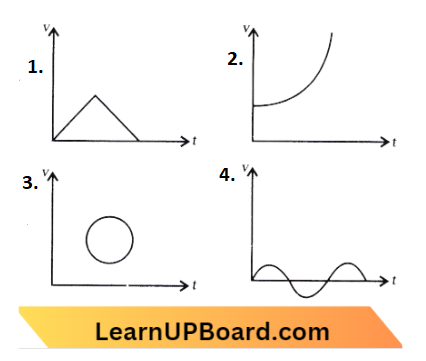
Answer: 4.
In option 3, particles have two velocities at a particular instant of time, which is impossible.
Question 22. A particle of unit mass undergoes one-dimensional motion such that its velocity varies according to v(x) = β-2n where β and n are constants and x is the position of the particle. The acceleration of the particle as a function of x is given by:
- – 2nβ2 x-2n-1
- – 2nβ2 x-4n-1‘
- – 2nβ2 x-2n+1
- – 2nβ2e-4n+1
Answer: 2. – 2nβ2 x-4n-1‘
Given
A particle of unit mass undergoes one-dimensional motion such that its velocity varies according to v(x) = β-2n where β and n are constants and x is the position of the particle.
The velocity (v) as a function position of a particle is given by,
v = bx-2n
Acceleration, \(a=\frac{d v}{d t}=\frac{d x}{d t} \cdot \frac{d v}{d x}\)
⇒ \(a=\frac{d v}{d x} \cdot v=v \cdot \frac{d v}{d x}\)
=\(\beta x^{-2 n} \cdot\left(-2 n \beta x^{-2 n-1}\right)\)
∴ a=\(-2 n \beta^2 x^{-4 n-1}\)
NEET Physics MCQs
Question 23. A balloon with mass m depends on an acceleration a (where a < g). How much mass should be removed from it so that it starts moving up with an acceleration?
- \(\frac{2 m a}{g+a}\)
- \(\frac{2 m a}{g-a}\)
- \(\frac{m a}{g+a}\)
- \(\frac{m a}{g-a}\)
Answer: 1. \(\frac{2 m a}{g+a}\)
According to the question when it descends with acceleration a,
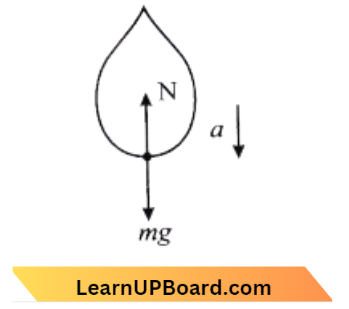
mg – N=ma → 1
N = Buoyant force
In the second case let a new mass of between in m,
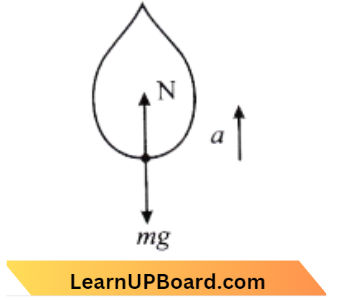
removed mass = m – m’ ⇒N-mg = ma → 2
Solving eq. 1 and 2,
mg-N=ma
N- m’g = m’a
mg- m’g = m’a + m’a
= ma + m’a
mg-ma -m'(g + a)
m(g-a) = m'(g + a)
\(m^{\prime}=\frac{m(g-a)}{g+a}\) → 3
Now removed mass is m0- m’ = Am
From eq. 3 we get \(m-m^{\prime} =m-\frac{m(g-a)}{g+a}\)
=\(m\left[1-\frac{g-a}{g+a}\right]\)
=\(m\left[\frac{g+a-(g-a)}{g+a}\right]\)
=\(m\left[\frac{2 a}{g+a}\right]\)
∴ \(\Delta m =\frac{2 m a}{g+a}\)
NEET Physics MCQs
Question 24. A body is moving with a velocity of 30 m/s towards the east. After 10 s its velocity becomes 40 m/s towards the north. The average acceleration of the body is:
- 7 m/s2
- \(\sqrt{7} \mathrm{~m} / \mathrm{s}^2\)
- 5 m/s2
- 1 m/s2
Answer: 3. 5 m/s2
Average Acceleration
⇒\(\vec{a}_{\mathrm{avg}}=\frac{\overrightarrow{\mathrm{v}}_f-\overrightarrow{\mathrm{v}}_i}{t}=\frac{40 \hat{j}-30 \hat{i}}{10}\)
∴ \(\vec{a}_{\text {avg }}=\sqrt{\frac{40^2+30^2}{10}}=5 \mathrm{~m} / \mathrm{sec}^2\)
Question 25. The position of a particle varies with time t, as x = at²-bt³. The acceleration of the particle will be zero at time t equals:
- zero
- \(\frac{a}{3 b}\)
- \(\frac{2 a}{3 b}\)
- \(\frac{a}{b}\)
Answer: 2. \(\frac{a}{3 b}\)
Acceleration, \(a=\frac{d v}{d t}=\frac{d^2 x}{d t^2}\)
Velocity, \(v=\frac{d x}{d t}\)
The given equation is, x= at² – bt³
Velocity = \(v=\frac{d x}{d t}=2 a t-3 b t^2\)
Acceleration \(a=\frac{d v}{d t}=2 a-6 b t\)
but a=0,
∴ 2a- 6bt = 0
Class 11 Motion in a Straight Line MCQs
Question 26. The ratio of the distances travelled by a freely falling body in the 1st, 2nd, 3rd and 4th second:
- 1: 4 : 9: 16
- 1 : 3: 5: 7
- 1 : 1: 1: 1
- 1: 2 : 3: 4
Answer: 2. 1 : 3 : 5: 7
⇒ \(\mathrm{S}_{\mathrm{nth}}= u+\frac{a}{2}(2 n-1)\)
=\(0+\frac{a}{2}(2 n-1)\)
\(\mathrm{S}_{\mathrm{nth}} \alpha(2 n-1)\)⇒\(\quad \mathrm{S}_{1 \mathrm{st}}: \mathrm{S}_{2 \mathrm{nd}}: \mathrm{S}_{3 \mathrm{rd}}: \mathrm{S}_{4 \text { th }} \)
=\({[2(1)-1]:[2(2)-1]:[2(3)-1]:[2(4)-1] }\)
= 1: 3: 5: 7
Question 27. The displacement-time graphs of two moving particles make angles of 30° and 45° with the x-axis as shown in the figure. The ratio of their respective velocity is:
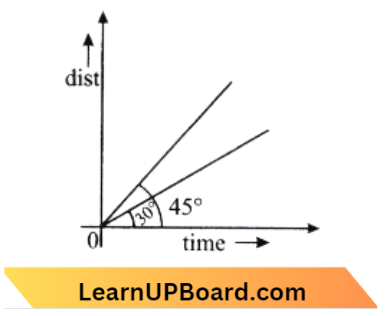
- 1:1
- 1:2
- \(1: \sqrt{3}\)
- \(\sqrt{3}: 1\)
Answer: 3. \(1: \sqrt{3}\)
Let displacement be s and time be t and y-intercept is zero. S = ut + 0 ⇒ S = ut,
where u is velocity as per laws of motion Also u is the slope of the graph s vs t.
u = tan θ
u1 = tan 30°
⇒ \(\mathrm{u}_1=\frac{1}{\sqrt{3}}\) ⇒\(\mathrm{u}_2=\tan 45^{\circ}\)
⇒ \(\mathrm{u}_2=1\)
∴u1: u2=\(\frac{1}{\sqrt{3}}: 1\)
∴u1: u2 =1:\(\sqrt{3}\)
Class 11 Motion in a Straight Line MCQs
Question 28. A small block slides down on a smooth inclined plane, starting from rest at time t = 0. Let Sn be the distance travelled by the block in the interval t = n – 1 to t = n. Then the ratio \(\frac{\mathrm{S}_n}{\mathrm{~S}_{n+1}}\) is:
- \(\frac{2 n-1}{2 n}\)
- \(\frac{2 n-1}{2 n+1}\)
- \(\frac{2 n+1}{2 n-1}\)
- \(\frac{2 n}{2 n-1}\)
Answer: 2. \(\frac{2 n-1}{2 n+1}\)
Given,
A small block slides down on a smooth inclined plane, starting from rest at time t = 0. Let Sn be the distance travelled by the block in the interval t = n – 1 to t = n.
Distance =Sn
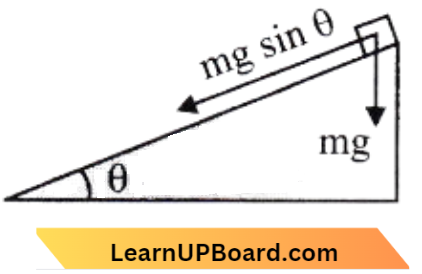
Time t=n-1 to t=n-1
⇒\(\frac{\mathrm{S}_n}{\mathrm{~S}_{n+1}}=?\)
∴a=g sinθ
Initial time\(\mathrm{S}=u t+\frac{1}{2} a t^2\)
⇒\(\mathrm{~S}=u t+\frac{1}{2} g \sin \theta t^2\)
Since u=0
⇒\({S}=\frac{1}{2} a t^2\)
Case 1 time interval t=n-1 to t=n
⇒\(\mathrm{S}_n =\frac{1}{2} a n^2-\frac{1}{2} a(n-1)^2\)
=\(\frac{1}{2} a\left(n^2-n^2-1+2 n\right)\)
⇒\(\mathrm{S}_n =\frac{1}{2} a(2 n-1)\)
\(\mathrm{S}_{n+1} =\frac{1}{2} a(n+1)^2-\frac{1}{2} a n^2\) =\(\frac{1}{2} a\left(n^2+1+2 n-n^2\right)\)
=\(\frac{1}{2} a(2 n+1)\)
∴\(\frac{\mathrm{S}_n}{\mathrm{~S}_{n+1}} =\frac{2 n-1}{2 n+1}\)
Important MCQs on Motion in a Straight Line
Question 29. A conveyor belt is moving at a constant speed of 2 m/s. A box is gently dropped on it. The coefficient of friction between them is p = 0.5. The distance that the box will move relative to the belt before coming to rest on it taking g = 10 ms-2, is:
- 1.2 m
- 0.6 m
- zero
- 0.4 m
Answer: 4. 0.4 m
Here, F = μmg Retardation of the block on the belt,\(a=\frac{F}{m}=\frac{\iota m g}{m}=\mu \mathrm{g}\)
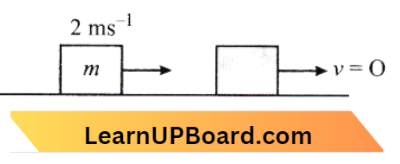
⇒From third equation of motion, v2 = w2 + 2as ⇒ 0 = (2)2 – 2(μg)s
∴\(s=\frac{4}{2 \times 0.5 \times 10}=0.4 \mathrm{~m}\)
Question 30. Ship A is moving westwards with a speed of 10 km h-1 and ship B 100 km South of A, is moving Northwards with a speed of 10 km hr1. The time after which the distance between them becomes shortest is:
- O h
- 5 h
- \(5 \sqrt{2} h\)
- \(10 \sqrt{2} h\)
Answer: 2. 5 h
From the diagram, the distance S between the ships is \(S=\sqrt{(100-x)^2+x^2}\)[From A To B]
⇒\(for_{\min }, \quad \frac{d s}{d x}=0\)
[- 2 (100-x) + 2x] = 0 ⇒ 4x – 200 = 0 ⇒ x = 50
⇒\(\quad \frac{d s}{d x}=\frac{1}{2\left[(100-x)^2+x^2\right]^{-1 / 2}}\)
∴So after both the ships have covered 50 m. The time taken is \(t=\frac{x}{10}=\frac{50}{10}=5 h\)
Important MCQs on Motion in a Straight Line
Question 31. A stone falls freely under gravity. It covers distances h1, h2 and h3 in the first 5 seconds, the next 5 seconds and the next 5 seconds respectively. The relation between h1,h2 and h3 is:
- \(h_1=2 h_2=3 h_2\)
- \(h_1=\frac{h_2}{3}=\frac{h_3}{5}\)
- \(h_2=3 h_1 and h_3=3 h_2\)
- \(4 i=h_2=h_2\)
Answer: 2. \(h_1=\frac{h_2}{3}=\frac{h_3}{5}\)
Here, \(h_1=\frac{1}{2} g t^2=\frac{1}{2} g(5)^2=125\)
⇒\(h_2=\frac{1}{2} g t^2=\frac{1}{2} g(10)^2=375\)
⇒\(h_3=\frac{1}{2} g t^2=\frac{1}{2} g(15)^2=625\)
∴\(h_1=\frac{h_2}{3}=\frac{h_3}{5}\)
Question 32. A particle starts its motion from rest under the action of a constant force. If the distance covered in the first 10 s is s1 and that covered in the first 20 s is s2, then:
- s2 = 2 S1
- s2 = 3S1
- s2 = 4 S1
- s2 = S1
Answer: 3. s2 = 4 S1
We know the second equation of motion,\(S=u t+\frac{1}{2} a t^2\)
⇒When, \(u=0: S=\frac{1}{2} a t^2\)
⇒ \(S_1=\frac{1}{2} a(10)^2\)
⇒\(S_2=\frac{1}{2} a(20)^2\)
\(\frac{S_1}{S_2}=\frac{(10)^2}{(20)^2}=\frac{1}{4}\) ⇒ s2=4s1
Question 33. The distance travelled by a particle starting from rest and moving with an acceleration\(\frac{4}{3}\)ms~2, in the third second is:
- 6 m
- 4m
- \(\frac{10}{3} \mathrm{~m}\)
- \(\frac{19}{3} \mathrm{~m}\)
Answer: 3. \(\frac{10}{3} \mathrm{~m}\)
Distance covered in nth second,
⇒\(\mathrm{S}_n=u+\frac{1}{2} a(2 n-1)\)
=\(0+\frac{1}{2} \times \frac{4}{3}(2 \times 3-1)=\frac{1}{2} \times \frac{4}{3} \times 5\)
=\(\frac{10}{3} \mathrm{~m}\)
Physics MCQs for NEET with Answers
Question 34. A particle moves along a straight line OX. At a time t (in seconds) the distance x (in metres) of the particle from O is given by x = 40 + 12t-P. How long would the particle travel before coming to rest?
- 16 m
- 24 m
- 40 m
- 56 m
Answer: 1. 16 m
The given equation is X = 40 + 127- 13
On differentiating, we get \(u=\frac{d x}{d t}=12-3 t^2\)
When the particle comes to rest means, v = 0
12-3t2=0 ⇒ t=2
The Distance travelled before coming to rest \(\int_0^5 d s=\int_0^2 v d t\)
⇒\({[s]_0^5 }=\int_0^2\left(12-3 t^2\right) d t\)
=\(\left[12 t-\frac{3 t^3}{3}\right]_0^2\)
=12 x 2 -(8-0) = 16 m
Question 35. The displacement x of a particle varies with time t as x = ae-at + bβt, where a, b, a and (3 are positive constants. The velocity of the particle will:
- be independent of β
- drop to zero when α =β
- go on decreasing with time
- go on increasing with time
Answer: 4. go on increasing with time
From question, x = ae-αt + beβt
⇒ \(v=\frac{d x}{d t}=-a \alpha e^{-\propto t}+b \beta_e^{\mathrm{B}+}\)
⇒ v=-a α e-t + b βξβt
∴Velocity will decrease for a certain value of t.
Question 36. If a ball is thrown vertically with speed u, the distance covered during the last t seconds of its ascent is:
- ut
- \(\frac{1}{2} g t^2\)
- \(u t-\frac{1}{2} g t^2\)
- \((u+g t) t\)
Answer: 2. \(\frac{1}{2} g t^2\)
Let the time of flight be T, Then \(T=\frac{u}{g}\)
Again, Let h be the distance covered during the last second of its ascent.
⇒\(=u-g\left(\frac{u}{g}-t\right)=g t\)
∴Velocity at point B, vB =u – g (T -t)
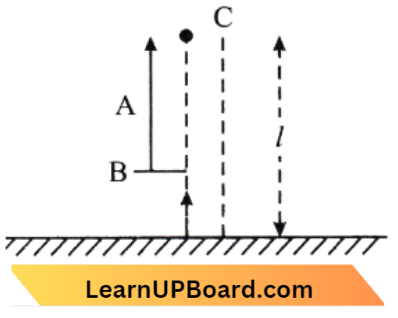
⇒h=\(h=v_B t-\frac{1}{2} g t^2\)
Physics MCQs for NEET with Answers
Question 37. A man throws balls with the same speed vertically upwards one after the other at an interval of 2 seconds. What should be the speed of the throw so, more than two balls are in the sky at any time?
- more than 19.6 m/s
- at least 9.8 m/s
- any speed less than 19.6 m/s
- only with a speed of 19.6 m/s
Answer: 1. more than 19.6 m/s
From question Interval of a ball thrown = 2 sec
If we want a minimum of three balls to remain in the air then the time of flight of the first ball must be greater than 4 sec. ⇒T > 4sec
⇒\(\frac{2 u}{g}>4 \mathrm{sec}\)
∴4 > 19.6 m/s
Question 38. A car moving with a speed of 40 km/h can be stopped after 2 m by applying brakes. If the same car is moving at a speed of 80 km/h, what is the minimum stopping distance?
- 8m
- 2m
- 4m
- 6m
Answer: 1. 8m
According to the conservation of energy, the kinetic energy of the car = work done in stopping the car
⇒\(\frac{1}{2} m v^2=F s\)
where F is the retarding force and s is the stopping distance. For the same retarding force s α v2
⇒\(\frac{s_2}{s_1}=\left(\frac{v_2}{v_1}\right)=\left(\frac{80}{40}\right)^2=4\)
∴s2=4s1=4×2
Physics MCQs for NEET with Answers
Question 39. If a ball is thrown vertically upwards with a velocity of40 m/s, then velocity of the ball after 2s will be(g = 10 m/s2):
- 15 m/s
- 20 m/s
- 25 m/s
- 28 m/s
Answer: 2. 20 m/s
Here, the initial velocity of the ball, u = 40 m/s2
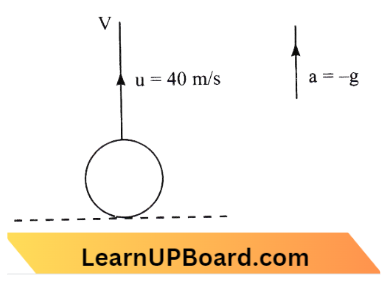
Acceleration of ball, a=-gm/s2 = – 10 m/s2
Time = 2s
⇒From the first equation of motion,
∴v = u + at = 40 – 10 x 2⇒ v = 20 m/s
Question 40. The speed of a swimmer in still water is 20 m/s. The speed of river water is 10 m/s and is flowing to the east. If he is standing on the south bank and wishes to cross the river along the shortest path the angle at which he should make his strokes w.r.t. north is given by:
- 0°
- 60° west
- 45° west
- 30° west
Answer: 4. 30° west
Here, vSR = 20 m/s
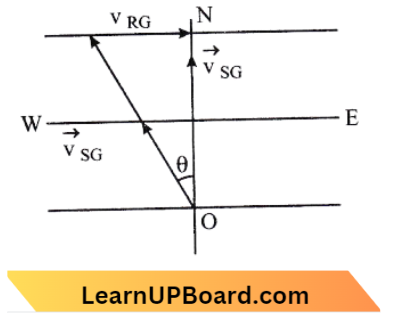
VRG = 10 m/s
⇒\(\sin \theta=\left|\frac{\vec{v}_{R G}}{\overrightarrow{v_{S R}}}\right|=\frac{10}{20}=\frac{1}{2}\)
∴θ= 30° west.
Chapter-Wise Physics MCQs for NEET
Question 41. The two bullets are fixed horizontally and simultaneously towards each other from the rooftops of two buildings 100 m apart and of the same height of 200 m with the same velocity of 25 m/s. When and where will the two bullets collide (g = 10 m/s2)?
- After 2s at a height of 180 m
- After 2s at a height of 20 m
- After 4s at a height of 120 m
- They will not collide
Answer: 1. After 2s at a height of 180 m
Given
The two bullets are fixed horizontally and simultaneously towards each other from the rooftops of two buildings 100 m apart and of the same height of 200 m with the same velocity of 25 m/s.
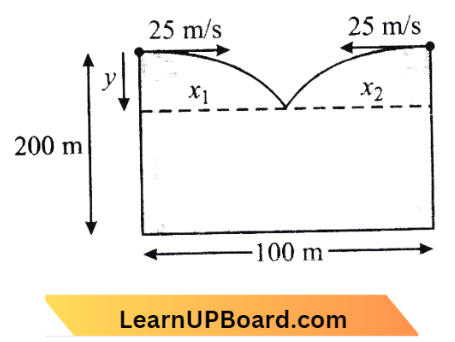
Let bullet collide at time t,
x1 + X2 = 100 m 25/+ 25/= 100
t = 2s
\(y=\frac{1}{2} g t^2=\frac{1}{2} \times 10 \times 2^2\) = 20 m ⇒h = 200-20= 180 m
∴Hence, bullets will collide after 2s at a height of 180 m above the ground.
Question 42. An object of mass 500 g, initially at rest acted upon by a variable force whose X components vary with X in the manner shown. The velocities of the object a point X = 8 m and X = 12 m, would be the respective values of (nearly):

- 18 m/s and 24.4 m/s
- 23 m/s and 24.4 m/s
- 23 m/s and 20.6 m/s
- 18 m/s and 20.6 m/s
Answer: 3. 23 m/s and 20.6 m/s
Given
An object of mass 500 g, initially at rest acted upon by a variable force whose X components vary with X in the manner shown. The velocities of the object a point X = 8 m and X = 12 m,
From the work-energy theorem,
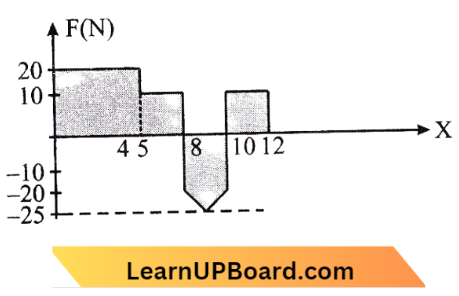
K = work = area under F-X graph from
X = 0 to X=8m
⇒ \(\frac{1}{2} m v^2\)100 + 30
⇒\(\frac{1}{2} \times \frac{1}{2} \times v^2 =130\)
⇒\(v^2 =520\)
⇒\(v =\sqrt{520}=23 m/s\)
from X = 0 to X =12m ⇒\(\frac{1}{2} m v^2 =100+30-47.5+2\)
⇒v =\(\sqrt{410}\)
∴v= 20.6m/s
Chapter-Wise Physics MCQs for NEET
Question 43. Two boys are standing at the ends A and B of a ground where AB = a. The boy at B starts running in a direction perpendicular to AB with velocity v1. The boy at A starts running simultaneously with velocity v and catches the other in time t, where t is equal to:
- \(\frac{a}{\sqrt{v^2+v_1^2}}\)
- \(\frac{a}{v+v_1}\)
- \(\frac{a}{v-v_1}\)
- \(\sqrt{\frac{a^2}{v^2-v_1^2}}\)
Answer: 4. \(\sqrt{\frac{a^2}{v^2-v_1^2}}\)
Given
Two boys are standing at the ends A and B of a ground where AB = a. The boy at B starts running in a direction perpendicular to AB with velocity v1. The boy at A starts running simultaneously with velocity v and catches the other in time t,
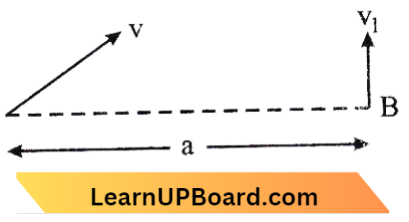
∴t=\(\frac{a}{v^{\prime}}=\frac{a}{\sqrt{v^2-v_1^2}}\)
